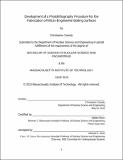| dc.contributor.advisor | Matteo Bucci. | en_US |
| dc.contributor.author | Cassidy, Christopher(Christopher M.) | en_US |
| dc.contributor.other | Massachusetts Institute of Technology. Department of Nuclear Science and Engineering. | en_US |
| dc.date.accessioned | 2020-01-08T19:35:41Z | |
| dc.date.available | 2020-01-08T19:35:41Z | |
| dc.date.copyright | 2019 | en_US |
| dc.date.issued | 2019 | en_US |
| dc.identifier.uri | https://hdl.handle.net/1721.1/123369 | |
| dc.description | This electronic version was submitted by the student author. The certified thesis is available in the Institute Archives and Special Collections. | en_US |
| dc.description | Thesis: S.B., Massachusetts Institute of Technology, Department of Nuclear Science and Engineering, 2019 | en_US |
| dc.description | Cataloged from student-submitted PDF version of thesis. | en_US |
| dc.description | Includes bibliographical references (page 38). | en_US |
| dc.description.abstract | Boiling is a very effective heat removal process, used for heat management in many engineering systems, such as electronic devices or nuclear reactors. However, if the heat flux to remove exceeds the so-called Critical Heat Flux (CHF), the process fails, leading the whole system to failure. A higher CHF is desirable, as it translates into higher power density or, in the case of nuclear reactors, a high power rating. Thus, many researchers are exploring solutions to increase this limit by engineering the boiling surface. However, while promising results have been obtained, the enhancement mechanisms, and how to optimize them, are not clear. The goal of this project was to develop a procedure for fabricating special "research" boiling surfaces to explore these phenomena. These surfaces have well-controlled features. These consist of a layer of copper with star-shaped holes 250 or 500 microns in diameter and 10 microns deep. The steps to create this surface involve photolithography with a positive photoresist, to create the pillars (filled-in holes), and electroplating to build the surface around the pillars. The procedure developed requires a double coat of AZ 9260, exposure, partial development in AZ 435, and re-exposure and developing to achieve the desired thickness. Electroplating at very low current, roughly 0.015 A (3.75 mA/cm2), with minimal stirring, yields a uniform layer of copper. This method will be applied to the fabrication of heaters for boiling experiments. Should these experiments demonstrate a substantial increase in CHF, this procedure could serve as a first step towards applying the technology to industrial surfaces, such as nuclear reactor claddings. | en_US |
| dc.description.statementofresponsibility | by Christopher Cassidy. | en_US |
| dc.format.extent | 38 pages | en_US |
| dc.language.iso | eng | en_US |
| dc.publisher | Massachusetts Institute of Technology | en_US |
| dc.rights | MIT theses are protected by copyright. They may be viewed, downloaded, or printed from this source but further reproduction or distribution in any format is prohibited without written permission. | en_US |
| dc.rights.uri | http://dspace.mit.edu/handle/1721.1/7582 | en_US |
| dc.subject | Nuclear Science and Engineering. | en_US |
| dc.title | Development of a photolithography procedure for the fabrication of micro-engineered boiling surfaces | en_US |
| dc.type | Thesis | en_US |
| dc.description.degree | S.B. | en_US |
| dc.contributor.department | Massachusetts Institute of Technology. Department of Nuclear Science and Engineering | en_US |
| dc.identifier.oclc | 1134982539 | en_US |
| dc.description.collection | S.B. Massachusetts Institute of Technology, Department of Nuclear Science and Engineering | en_US |
| dspace.imported | 2020-01-08T19:35:37Z | en_US |
| mit.thesis.degree | Bachelor | en_US |
| mit.thesis.department | NucEng | en_US |
